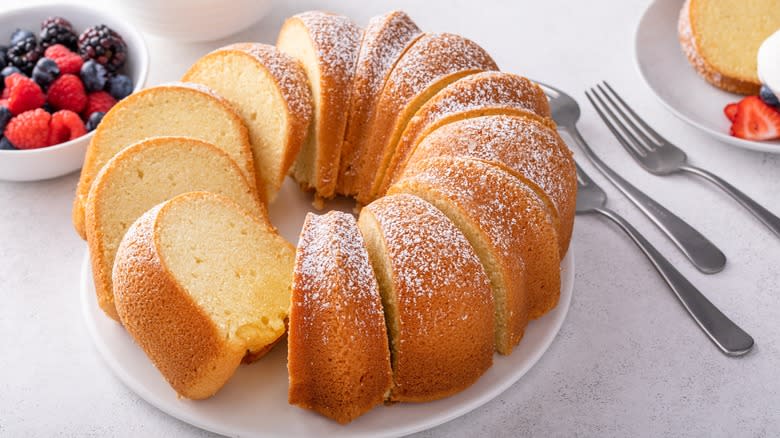The Simple Paste That Makes Removing Bundt Cakes Effortless

When you're baking up a bundt cake, it's important to take precautions to prevent the dessert from sticking to the pan. Otherwise, when it's time to remove it, you may break off chunks of the cake, or wind up with an uneven texture on the outside. And since bundt cakes aren't always coated with a full layer of frosting on the outside, you'll want a nicer-looking cake surface.
Fortunately, so long as the baking pan has been properly greased and floured, it should be easy to remove. This is typically done by spreading some shortening around the inside of the pan, then sprinkle in a loose layer of flour. If you're looking to save yourself some time, however, you can pre-make a paste to spread both on at the same time. To make the paste, also called "cake goop," simply mix together equal parts of a neutral-flavored oil, vegetable shortening, and flour. All you'll need to do is whisk the ingredients together, then coat the inside of your baking pan with the mixture.
Read more: Cake Hacks Every Baker Will Wish They Knew Sooner
What To Make The Paste With

The mix of oil, shortening, and flour in the paste is similar to the composition of canned baking sprays that, like those from Baker's Joy and Pam, which generally contain oil and flour. You'll want to make sure you choose a neutral flavored oil when making the paste, like sunflower or vegetable. Any oil with a stronger flavor may impact the taste of the final cake.
All-purpose flour is generally best for this application, though gluten-free flour will also work for celiac-friendly bakes. Once the mixture is prepared, it can be spread around in the pan. You may even want to use a silicone or bristled pastry brush to ensure every area is coated evenly. Then, pour the cake batter in and bake as normal. If you wind up with any leftover paste, it can be stored in an airtight container for future bakes. Since all the ingredients are shelf stable, it will hold up at cooler room temperatures for about a month.
Bundt Cakes Can Be Especially Sticky

Greasing and flouring a pan is important for ensuring your bakes come out smoothly — especially when baking a bundt cake. Simple bundt cake pans feature bumps around the entire ring, while more intricate ones have patterns or designs molded into the pan. The process will protect the cake from sticking to the pan as it bakes, and it will allow the dessert to be removed from the pan more easily. Bundt pants are sometimes made out of a nonstick material, but that doesn't mean they're foolproof. Over time, that coating can wear down or become scratched, creating even more areas where the cake can stick to.
According to King Arthur Baking, bundt cake recipes that include butter may be especially susceptible to sticking. The site states that butter's milk solids become especially sticky and cling to the pan, making it harder to remove the dessert. Fortunately, if you coat your cake pan in the oil/shortening/flour paste, there will be a slippery barrier between the batter and the pan.
The next time you're baking up a bunch of bundt cakes, save yourself some time when it comes to pan prep. Rather than greasing and flouring each cake pan individually, make a paste to spread around before baking.
Read the original article on Daily Meal.

